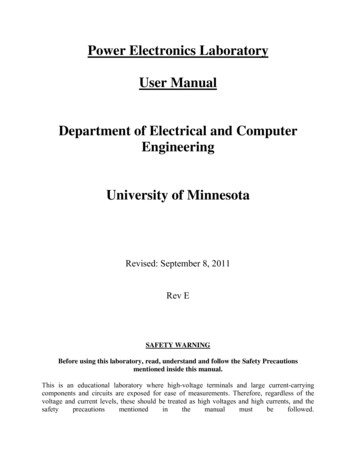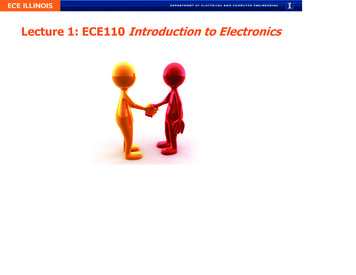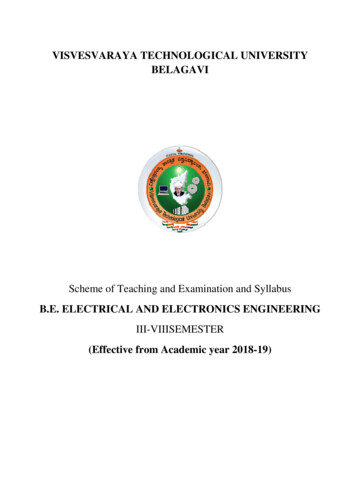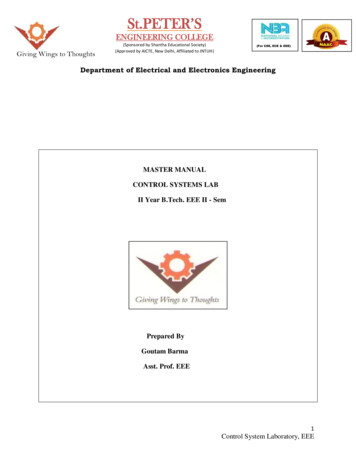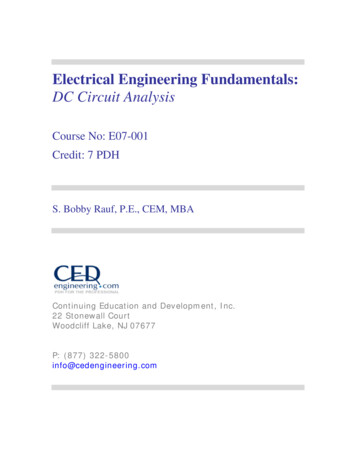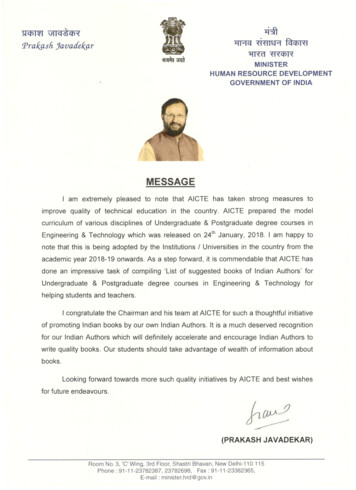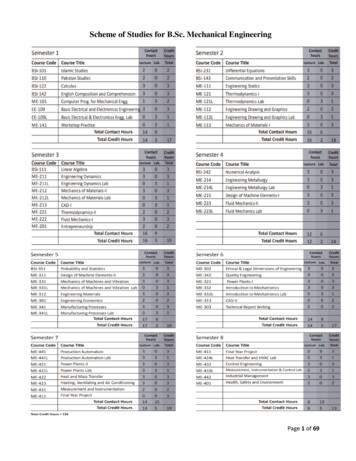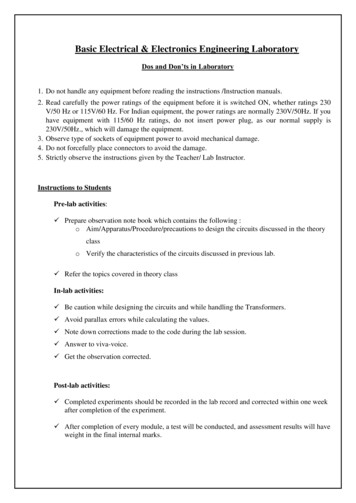
Transcription
Basic Electrical & Electronics Engineering LaboratoryDos and Don’ts in Laboratory1. Do not handle any equipment before reading the instructions /Instruction manuals.2. Read carefully the power ratings of the equipment before it is switched ON, whether ratings 230V/50 Hz or 115V/60 Hz. For Indian equipment, the power ratings are normally 230V/50Hz. If youhave equipment with 115/60 Hz ratings, do not insert power plug, as our normal supply is230V/50Hz., which will damage the equipment.3. Observe type of sockets of equipment power to avoid mechanical damage.4. Do not forcefully place connectors to avoid the damage.5. Strictly observe the instructions given by the Teacher/ Lab Instructor.Instructions to StudentsPre-lab activities: Prepare observation note book which contains the following :o Aim/Apparatus/Procedure/precautions to design the circuits discussed in the theoryclasso Verify the characteristics of the circuits discussed in previous lab. Refer the topics covered in theory classIn-lab activities: Be caution while designing the circuits and while handling the Transformers. Avoid parallax errors while calculating the values. Note down corrections made to the code during the lab session. Answer to viva-voice. Get the observation corrected.Post-lab activities: Completed experiments should be recorded in the lab record and corrected within one weekafter completion of the experiment. After completion of every module, a test will be conducted, and assessment results will haveweight in the final internal marks.
BEE LABDEPARTMENT OF EEEGeneral Instructions: Student should sign in the log register before going to the test bench (experiment bench). Student is only responsible for any damage caused to the equipment in the laboratory duringhis session. If a problem is observed in any hardware equipment, please report to the lab staffimmediately; do no attempt to fix the problem yourself. After completion of the experiment, components must be submitted properly to the labFaculty. Please be considerate of those around you, especially in terms of noise level. While labs area natural place for conversations regarding designing the circuit, kindly keep the volumeturned downInstruction for Laboratory Teachers:1. Submission related to whatever lab work has been completed should be done during the nextlab session.2. Students should be instructed to switch on the power supply after getting the checked by thelab assistant / teacher. After the experiment is over, the students must hand over the circuitboard, wires, CRO probe to the lab assistant/teacher.3. The promptness of submission should be encouraged by way of marking and evaluationpatterns that will benefit the sincere students.LENDI INSTITUTE OF ENGINEERING & TECHNOLOGY1
BEE LABDEPARTMENT OF EEEList of ExperimentsSection A: Electrical Engineering:1. Swimburne's test on D.C. Shunt machine (predetermination of efficiency of a givenD.C. shunt machine working as motor and generator).2. O.C and S.C test on single phase transformer (predetermination of efficiency andregulation at given power factor.3. Brake test on 3- phase induction motor (determination of performance characteristics).4. Regulation of alternator by Synchronous impendence method.5. Speed control of DC shunt motor by a) Armature voltage control b) Field flux controlmethod.6. Brake test on DC shunt motor.Section B: Electronics Engineering:7. PN junction Diode Characteristics.a) Forward biasb) Reverse bias (Cut-in voltage and resistance calculations).8. Transistor CE characteristics (Input and Output).9. Full wave rectifier with and without filters.10. CE Amplifiers.11. Class A Power Amplifier.12. RC Phase Shift Oscillator.LENDI INSTITUTE OF ENGINEERING & TECHNOLOGY2
DEPARTMENT OF EEEBEE LABExp No: 1Date:SWINBURNE’S TESTAIM: To perform Swinburne’s test on a given DC Shunt machine and predetermine its efficiencyat any desired load, both as a motor & as a generator.NAME PLATE DETAILS:APPARATUS:THEORY:This test is to find out the efficiency of the machine .It is a simple indirect method in whichlosses are determined separately and from their knowledge, efficiency at any desired load can bepredetermined. The only test needed is no-load test. This test cannot be performed on DC seriesmotor. The machine is run as a no load shunt motor at rated speed and with a rated terminal voltage.However, this test is applicable to those machines in which flux is practically constant. Theconstant losses in a dc shunt machine Wc stray losses (magnetic & mechanical losses) shuntfield copper lossesLENDI INSTITUTE OF ENGINEERING & TECHNOLOGY3
BEE LABDEPARTMENT OF EEECIRCUIT DIAGRAM:CIRCUIT DIAGRAM TO FIND ARMATURE RESISTANCE:PROCEDURE:1. The connections are made as per the circuit diagram.2. Initially the starter is in OFF position & the field rheostat is kept in minimum position.3. 220V DC supply is applied by closing the DPST Switch.4. The DC motor is started slowly with the starter and brought to the rated speed by varying fieldrheostat.5. The no load readings of the motor (input current, field current and input voltage) are noted.6. Bring the rheostat to initial position and switch OFF of the machine by opening the DPST switch.PROCEDURE TO FIND Ra:1. Connections are made as per the circuit diagram.2. 20V DC supply is applied by closing the DPST Switch.3. Readings of ammeter & voltmeter are noted by varying the rheostat from maximum position tominimum position.LENDI INSTITUTE OF ENGINEERING & TECHNOLOGY4
BEE LABDEPARTMENT OF EEETABULAR FORM:S.NoInput voltage(V)volts1Input Current IL(amps)Field current Ish(amps)Armature Resistance Ra 3.4 ΩFor Motor:LoadSupplyVoltage(V)LineCurrent IL(A)Arm.Current,Ia(A)Speed,N(rpm)FieldCurrent, Ish(A)WcPout,(W)η (%)Pin,(W)η (%)Full3/41/21/4For Generator:S.NoSupplyVoltage(V)LineCurrent IL(A)Arm.Current,Ia(A)Speed,N(rpm)FieldCurrent, Ish(A)Full3/41/21/4MODEL CALUCALATIONS:Constant Losses Wc VIL – (Ia)2 RaEfficiency of a Generator at Full load:Full Load Output V*IL -------- WArmature Copper losses at full load Total Losses Wc Ia2 R a -------------W% Output / (Output Total Losses) X 100 ------------Efficiency of a Motor:Let Ia is armature current at which efficiency is required.Input V*IL --------WArmature Cu loss -------------W2Total losses Ia R a Wc ----------------W % (Input –Total Losses / Input)* 100LENDI INSTITUTE OF ENGINEERING & TECHNOLOGY5Wc
BEE LABDEPARTMENT OF EEEModel Graph:PRECAUTIONS:1. Avoid loose connections.2. Switch off the Supply before making connections.3. Rheostat positions are checked before switching on the motor4. Do not touch the bare conductors.5. Avoid parallax error while making observations.RESULT:OUTCOME:Viva questions:1. What is the significance of swinburn’s test?2. What are the advantages & disadvantages of the test?3. Why it is not suitable for D.C series motor?4. What is the purpose of starter?5. What happened if field is open in D.C motor?6. Why we have to keep the field rheostat in minimum position?LENDI INSTITUTE OF ENGINEERING & TECHNOLOGY6
DEPARTMENT OF EEEBEE LABExp No: 2Date:O C AND S C TEST ON SINGLE PHASE TRANSFORMERAIM: To obtain the regulation and efficiency of a single phase transformer by conducting OC andSC test.NAME PLATE DETAILS:Transformer Specifications:S.NoSpecifications1Transformer Rating :( in KVA)2LV (in Volts)3LV side current4HV (in Volts)5HV side Current6Type (Shell/Core)7Frequency(Hz)Rating2 YPERANGEQUANTITYNo.12VoltmeterAmmeter(0-150)V1 no(0-60)V1 no(0-2)A1 no(0-10)A1 noMIMI(0-150)V LPF3WattmeterDynamo type1 no(0-2.5)A(0-150)V UPF4WattmeterDynamo type1 no(0-10)A5Connecting Wires*****LENDI INSTITUTE OF ENGINEERING & TECHNOLOGY*****7Required
BEE LABDEPARTMENT OF EEETHEORY:Transformer is a device which transforms the energy from one circuit to other circuitwithout change of frequency. The performance of any transformer can be determined by conductingtests. The OC and SC tests are conducted on transformer to find the efficiency and regulation of thetransformer at any desired load current.CIRCUIT DIAGRAMS:OPEN CIRCUIT TEST ON TRANSFORMERSHORT CIRCUIT TEST ON TRANSFORMERFuse1-Φ variacLENDI INSTITUTE OF ENGINEERING & TECHNOLOGY8
BEE LABDEPARTMENT OF EEEPROCEDURE:OPEN CIRCUIT TEST1. Connections are made as per the circuit diagram.2. By varying single phase variac, the rated input voltage to be applied on low voltage side of thetransformer.3. Now take down the readings of ammeter, voltmeter and wattmeter.SHORT CIRCUIT TEST1. Connections are made as per the circuit diagram.2. By varying the single phase varic, the rated current is applied to high voltage side of thetransformer.3. Now take down the readings of voltmeter and wattmeterTABULAR FORMS:OPEN CIRCUIT TEST:S.NO1Voc (Volts)Ioc (Amps)Woc(watts)Isc (Amps)Wsc(watts)SHORT CIRCUIT TEST:S.NO1Vsc (Volts)VOLTAGE REGULATION CHARACTERISTICS:S.No123456% load Sin Φ00.20.40.60.81Lagging P.F full loadRegulationLeading P.F full loadRegulation10.970.910.80.60EFFICIENCY CHARACTERISTICS:Load ,XLet CosΦ 0.8Efficiency, ηx 1/4x 1/2x 3/4x 1LENDI INSTITUTE OF ENGINEERING & TECHNOLOGY9Let Cos Φ 1Efficiency, η
BEE LABDEPARTMENT OF EEEMODEL CALUCALATIONS: Efficiency at Full load,KVA ,Woc W , Wsc WPercentage Regulation for lagging Power Factor:%R Percentage Regulation for leading Power Factor:%R MODEL GRAPHS:Efficiency Graph:Percentage Regulation Graph:LENDI INSTITUTE OF ENGINEERING & TECHNOLOGY10
BEE LABDEPARTMENT OF EEEPRECAUTIONS:1. Avoid the loose connections.2. Avoid connecting of meters directly to the machines.3. Switch OFF the supply before making the connections.4. Do not touch the bare conductors.5. Avoid parallax error while making observations.RESULT:OUTCOME:Viva questions:1. What is a transformer?2. Why transformer rated in KVA?3. What are the losses present in a transformer?4. What are the applications of transformer?5. What is voltage regulation of a transformer?LENDI INSTITUTE OF ENGINEERING & TECHNOLOGY11
DEPARTMENT OF EEEBEE LABExp No: 3Date:BRAKE TEST ON THREE PHASE INDUCTION MOTORAIM: To find the performance characteristics of three phase induction motor.NAME PLATE cationsPowerVoltageCurrentSpeedFrequencyPFRating3 I(0-600)V1 no2AmmeterMI(0-10)A1 no10A/600V UPF1 no10A/600V LPF1 no0-9999 RPM1 no3WattmeterElectro dynamo meter type4TachometerDigital5Connecting Wires*****CIRCUIT DIAGRAM:LENDI INSTITUTE OF ENGINEERING & TECHNOLOGY12*****Required
BEE LABDEPARTMENT OF EEETHEORY:It is the direct method to find the efficiency of the induction motor. In this test the brakingof the rotor is done with the help of the belt which surrounds the pulley by using spring balances.When the braking power is increased by tightening the springs then the line current is increased.PROCEDURE:1. Connections are made as per the circuit diagram.2. With the help of three phase variac, start the machine and run it at no-load. Take thereadings of all meters and measure the speed.3. Gradually tightening the belt, apply the load in steps.4. At each load take the readings of all meters and measure the speed.5. Pour water into pulley and cool it when motor is heated.6. When the full load is reached, slowly reduce the load and stop the machine by disconnectedthe pm)W1W2SpringBalanceS1S2TorqueN-mPin W1 W2(W)Pout,(W)η Pout/Pin X 100(%)12345678CALCULATIONS:Torque 9.81(S1-S2) R N-mOutput Power 2πNT/60Input Power W1 W2% Efficiency (Output/ Input) x100PRECAUTIONS:1. Avoid loose connections.2. Take the readings without parallax error.3. Double check the circuit before giving the supply.4. The motor armature rheostat in maximum position and motor field rheostat in minimum position.LENDI INSTITUTE OF ENGINEERING & TECHNOLOGY13
BEE LABDEPARTMENT OF EEERESULT:OUTCOME:Viva questions:1.2.3.4.5.Explain the working principle of an Induction Motor?What are the types of Induction Motor?Draw the performance characteristics of Induction Motor?Draw the equivalent circuit of Induction Motor?What are the applications of Induction Motor?LENDI INSTITUTE OF ENGINEERING & TECHNOLOGY14
DEPARTMENT OF EEEBEE LABExp No: 4Date:REGULATION OF A THREE-PHASE ALTERNATORAIM: To predict the regulation of Three Phase Alternator using synchronous impedance method.NAME PLATE peedExctnVoltageField currentRatingDC Motor(PrimeMover)5HP220V12A1500 rpmShunt Wound220V0.6A3- ɸ Alternator3.2KW415V4.2A1500 antity1VoltmeterMI(0-300/600)V1 no2AmmeterMI(0-10)A1 no300 Ω /2A2 noNo.3RheostatWire-wound4TachometerDigital0-10000 rpm1 no5Connecting Wires**********RequiredTHEORY:As the load changes the terminal voltage of an alternator is also changes the magnitude ofthis change depends not only on the load but also on load power factor. The voltage regulation of analternator is defined as the raise in voltage when the full load is removed (Field excitation andspeed remaining same) divided by the rated terminal voltage.%Regulation (Eo – V)/V X100LENDI INSTITUTE OF ENGINEERING & TECHNOLOGY15
BEE LABDEPARTMENT OF EEECIRCUIT DIAGRAM:PROCEDURE:1. Connections are made as per the circuit diagram.2. Switch ON the 220v DC supply.3. Start the DC Motor using 3 point starter.4. Adjust the speed of the motor to the rated speed using armature regulator and if necessary withfield regulators.5. Excite the field winding and vary the field current in steps of 0.1 amps and note down thecorresponding readings of voltmeter, keeping the speed constant.6. Repeat the procedure till 110 to 129 % of the rated voltage is reached.7. Reduce the field current to ‘0’ and close the ‘TPST’ switch.8. Vary the field current to ‘0’ and close the ‘TPST’ switch in steps of 0.1 amps and note down thecorresponding ammeter readings, keeping the speed constant.9. The procedure is Repeated till rated current is reachedLENDI INSTITUTE OF ENGINEERING & TECHNOLOGY16
BEE LABDEPARTMENT OF EEETABULAR FORM:OPEN CIRCUIT CHARACTERITICS:S.NOIf (amps)Voc (volts)123456SHORT CIRCUIT CHARACTERITICS:S.NOIf (amps)Isc (amps)1VOLTAGE REGULATION CHARACTERISTICS:S.No12345Cos Φ0.20.40.60.81Sin Φ Lagging P.F full load Eo0.970.910.80.60MODEL CALUCALATIONS: VZ Ω 1.5 X 4.2 6.3Ω ΩFor lagging P.F:By substituting all the values in Eo, We will getLENDI INSTITUTE OF ENGINEERING & TECHNOLOGY17Leading P.F full load Eo
BEE LABDEPARTMENT OF EEEFor leading P.F:By substituting all the values in Eo, We will getPercentage Regulation: % R MODEL GRAPH:PRECAUTIONS:1. Avoid loose connections.2. Switch OFF the Supply before making connections.3. Do not touch the bare conductors.4. Avoid parallax error while making observations.RESULT:OUTCOME:Viva questions:1. What is an Alternator?2. What is the principle of alternator?3. Define regulation of an Alternator?4. What are the different methods for finding regulation of an alternator?5. What are the applications of an alternator?LENDI INSTITUTE OF ENGINEERING & TECHNOLOGY18
BEE LABDEPARTMENT OF EEEExp No: 5Date:SPEED CONTROL OF DC SHUNT MACHINEAIM: To determine the speed characteristics of D.C. shunt motor by1. Field Control Method2. Armature Control MethodNAME PLATE DETAILS:S.No123SpecificationsRated VoltageRated SpeedField CurrentRating220V1500rmp1.2AAPPARATUS:THEORY:The term speed control means intentional sped variation, carried out manually orautomatically. DC motors are most suitable for wide range speed control and are thereforeindispensible for many adjustable speed drives. The speed of a motor is given by Wm (VtIaRa)/Kaф Where Ka – armature constant PZ/2 A and ф is the flux per pole. Hence it followsthat, for a DC motor, there are basically two methods of speed control and these are:1. Variation of the field flux.2. Variation of armature terminal voltage.Variation of the field flux: This method of speed control, also called as flux weakening method orfiled current control method gives speeds above the base speed only. Base speed is nothing but therated speed of the machine. This is one of the simplest and economical methods and is, thereforeextensively used in modern electric drives. Under steady state running conditions, if the field circuitresistance is increased, the field current and hence the field flux are reduced. Since the rotor speedcannot change suddenly due to inertia, a decrease in field current causes a reduction of counter emf.As a result of it, more current flows through armature. The percentage increase in armature currentis much more than the percentage decrease in the field current. In view of this, the electromagnetictorque is increased and this being more than the load torque, the motor gets accelerated.The disadvantages of this method are:a) The armature may get over heated at higher speeds, because the increased armaturecurrent results in more ohmic losses whereas cooling by ventilation does not improveproportionally.b) If the field flux is weakened considerably, the speed becomes very high and due to thesechanges; the motor operation may become unstable.LENDI INSTITUTE OF ENGINEERING & TECHNOLOGY19
BEE LABDEPARTMENT OF EEEVariation of armature terminal voltage: If the voltage applied to the armature changes the speedchanges directly with it. Using this method, speeds below rated speeds are attained.CIRCUIT DIAGRAM:For Field Control Method:For Armature Control Method:PROCEDURE:For Field Control method:1. The connections are made as per the circuit diagram.2. The field rheostat is kept at minimum position.3. The motor is started with the help of three point starter.4. Rf is increased in steps thereby decreasing the field current. The values of If and speed are notedFusedown.For Armature Control Method:1. The connections are made as per the circuit diagram.2. The armature rheostat is kept at maximum position.3. The motor is started with the help of the starter.LENDI INSTITUTE OF ENGINEERING & TECHNOLOGY20
BEE LABDEPARTMENT OF EEE4. The armature rheostat is varied from maximum value to minimum value in steps.5. The speed for each value of Va is noted down.TABULAR FORM:For Field Control Method:S.No.12345Field Current, ISh(A)Speed,N(rpm)For Armature Control Method:S.No.12345Arm. Voltage,Va (v)Speed,N(rpm)MODEL GRAPH:Armature voltage control:Field control method:PRECAUTIONS:1. Avoid loose connections.2. Switch OFF the Supply before making connections.3. Rheostat positions are checked before switching on the motor4. Do not touch the bare conductors.LENDI INSTITUTE OF ENGINEERING & TECHNOLOGY21
BEE LABDEPARTMENT OF EEE5. Avoid parallax error while making observations.RESULT:OUTCOME:Viva questions:1. Why to control the speed of a DC Motor?2. What is ment by armature reaction?3. Draw the characteristics of DC shunt motor?4. What is the expression for back EMF?5. What are the applications of Dc Motors?LENDI INSTITUTE OF ENGINEERING & TECHNOLOGY22
DEPARTMENT OF EEEBEE LABExp No: 6Date:BRAKE TEST ON A DC SHUNT MOTORAIM: To obtain the performance characteristic curves of a D.C. shunt motor by conducting braketest on itNAME PLATE DETAILS:APPARATUS:THEORY:It is a simple method testing DC machines and consists of applying a brake to a watercooled drum mounted on the motor shaft. A rope is wound round the pulley and its two ends areattached to two spring balances S1 & S2. The tension of the rope can be adjusted with the help ofswivels. The force acting tangentially on the drum is equal to the difference between the readings ofthea) This test can be used for small motors only, as, in the case of large motors, it is difficult todissipate the large amount of heat generated at the brake.b) Where the output power exceeds about 2 H.P., or where the test is of long duration, it’snecessary to use water –cooled pulley.LENDI INSTITUTE OF ENGINEERING & TECHNOLOGY23
BEE LABDEPARTMENT OF EEECIRCUIT DIAGRAM:PROCEDURE:1. The connections are made as per the circuit diagram.2. Initially the starter is in off position.3. The field rheostat is in minimum position.3. 220V DC supply is applied by closing the DPST Switch.4. The DC motor is started slowly with the starter and brought to the rated speed.5. Load is applied on the drum gradually in steps by tightening the belt around it.6. The readings of the ammeter & voltmeter, two spring balances and the speed at every step arenoted.7. Drum is cooled throughout the loading period by pouring water.8. The experiment is continued till the full load on the motor is impressed.9. The machine is switched OFF by opening the DPST switch.TABULAR FORM:S.NoSupplyVoltage(V)ArmCurrent Ia(A)Speed,N(rpm)SpringBalanceS1S21234567LENDI INSTITUTE OF ENGINEERING & TECHNOLOGY24FieldCurrent, Ish(A)Torque,T(Nm)Pin,(W)Pout,(W)η Pout/Pin X100(%)
BEE LABDEPARTMENT OF EEEMODEL CALUCALATIONS:LetS1 Readings on spring balance 1 in Kgf.wt.S2 Readings on spring balance 2 in Kgf.wt.The net force applied on the brake drum is (S1 – S2) Kgf.Wt.If R radius of the pulley in meters (15.2 Cm)N Motor speed in rpm then,Shaft torque, T, developed by the motor is:T 9.81 (S1 – S2) R N-mOutput power 2πNT/60 WattsInput power V (Ia Ish) Watts%Efficiency Output power / Input power X 100MODEL GRAPH:PRECAUTIONS:1. Avoid loose connections.2. Switch OFF the Supply before making connections.3. Rheostat positions are checked before switching on the motor4. Do not touch the bare conductors.5. Avoid parallax error while making observations.RESULT:LENDI INSTITUTE OF ENGINEERING & TECHNOLOGY25
BEE LABDEPARTMENT OF EEEOUTCOME:Viva questions:1.2.3.4.5.What is the principle of DC Motor?What is the need of starter?What are the types of speed control methods for DC motor?What are the parts of a DC motor?What are losses present in Dc motor?LENDI INSTITUTE OF ENGINEERING & TECHNOLOGY26
DEPARTMENT OF EEEBEE LABExp No: 7Date:P-N JUNCTION DIODE CHARACTERISTICSAIM: a) To observe and draw the V-I Characteristics of a P-N Junction diode in Forward andReverse bias.b) To calculate the cut-in voltage at which diode conducts.c) To calculate static and dynamic resistance.APPARATUS REQUIRED:S.No1234567Name of the apparatusPN Diode IN4007Regulated power supplyVoltmeterAmmeterResistorBread boardConnecting wiresQty112211-Range0-30V0-20V,0-1V0-20mA,0-750 µA1KΩ-THEORY:A p-n junction diode conducts only in one direction, the V-I characteristics of p-n diode is acurve plotted between the voltage across diode and current through the diode. When externalvoltage is zero, circuit is open and the potential barrier does not allow the current to flow.Therefore, the circuit current is zero. When P-type Anode is connected to ve terminal and N- typeCathode is connected to the –ve terminal of supply voltage the diode is considered to be operatingunder forward bias condition. When the voltage across the diode is increased in the forward biasedcondition, the potential barrier is reduced and is altogether eliminated at some forward voltage,resulting in the current to flow through the diode and the circuit. The diode is now said to be in theON state and the current keeps on increasing with an increase in the forward voltage.A p-n junction diode is considered to be operating under reverse bias condition when the Ntype cathode is connected to ve terminal and P-type Anode is connected to the –ve terminal ofsupply voltage. Under reverse bias condition potential barrier across the junction increases with acorresponding rise in the supply voltage, hence junction resistance becomes very high and a verysmall reverse saturation current flows in the circuit due to minority charge carriers. The diode isnow said to be in the OFF state.CIRCUIT DIAGRAM:Forward Bias:LENDI INSTITUTE OF ENGINEERING & TECHNOLOGY27
BEE LABDEPARTMENT OF EEEReverse Bias:Model Waveform:PROCEDURE:Forward Bias:1. Connections are made as per the circuit diagram.2. Under forward bias, the RPS ve terminal is connected to the anode of diode and RPS –veTerminal is connected to the cathode of the diode.3. Switch on the power supply and increase the input voltage (supply voltage) in Steps.4. Note down the corresponding current flowing through the diode and voltage across the Diode foreach and every step of the input voltage.5. Tabulate the readings of voltage and current.6. Plot the graph between voltage and current.7. Find the cut-in voltage in forward bias.8. Calculate the static and dynamic resistances.Reverse Bias:1. Connections are made as per the circuit diagram.2. Under reverse bias, the RPS -ve terminal is connected to the anode of diode and RPS veTerminal is connected to the cathode of the diode.3. Switch on the power supply and increase the input voltage (supply voltage) in Steps.4. Note down the corresponding current flowing through the diode and voltage across the Diode forLENDI INSTITUTE OF ENGINEERING & TECHNOLOGY28
BEE LABDEPARTMENT OF EEEeach and every step of the input voltage.5. Tabulate the readings of voltage and current.6. Plot the graph between voltage and current.7. Calculate the dynamic resistance.Observations for Forward Bias:S.NOAPPLIEDVOLTAGE(V)VOLTAGE ACROSSDIODE Vf (V)CURRENT THROUGHDIODE If (mA)1234567891011121314Observations for Reverse Bias:APPLIEDVOLTAGES.NO (V)VOLTAGE ACROSSDIODE VR(V)123456789101112LENDI INSTITUTE OF ENGINEERING & TECHNOLOGY29CURRENT THROUGHDIODE IR(µA)
BEE LABDEPARTMENT OF EEECalculations:Forward Bias:Static resistance RD VD/ID KΩDynamic resistance rd Vd/ Id KΩReverse Bias:Static resistance RD VD/ID KΩDynamic resistance rd Vd/ Id KΩApplications: As Rectifier in DC Power Supplies. In Demodulation or Detector Circuits. As DC Restorer in clamping networks. In clipping circuits used for waveform generation. As switches in digital logic circuits.PRECAUTIONS:1. Avoid loose connections.2. The supply voltage should not exceed the rating of the component.3. Meters should be connected properly according there polarity.RESULTS:Forward and Reverse Bias characteristics of p-n diode are obtained.Cut-in voltage Static Resistance in Forward Bias Dynamic resistance in Forward Bias Static Resistance in Reverse Bias Dynamic resistance in Reverse Bias OUTCOME:Viva Questions:1. Define depletion region of a diode?2. What is meant by transition & space charge capacitance of a diode?3. Is the V-I relationship of a diode Linear or Exponential?4. Define cut-in voltage of a diode and specify the values for Si and Ge diodes?5. What are the applications of a p-n diode?6. Draw the ideal characteristics of P-N junction diode?7. What is the diode equation?8. What is PIV?9. What is the break down voltage?10. What is the effect of temperature on PN junction diodes?11. How does the diode act as a switch?12. Differentiate cut-in and cut-off voltages?LENDI INSTITUTE OF ENGINEERING & TECHNOLOGY30
DEPARTMENT OF EEEBEE LABExp No: 8Date:TRANSISTOR COMMON EMITTER CHARACTERSTICSAIM: To draw the input and output characteristics of transistor connected in CE ConfigurationAPPARATUS REQUIRED:S.NoName of the apparatus1Transistor(BC 107)2Regulated power supply3Voltmeter4Ammeter5Resistor6Bread boardQty122211Range0-30V0-20V0-20mA,0-750 µA1KΩ-THEORY:A transistor is a three terminal device. The terminals are emitter, base, collector. In commonemitter configuration, input voltage is applied between base and emitter terminals and output istaken across the collector and emitter terminals. Therefore the emitter terminal is common to bothinput and output.The input characteristics resemble that of a forward biased diode curve. This is expectedsince the Base-Emitter junction of the transistor is forward biased. As compared to CB arrangementIB increases less rapidly with VBE. Therefore input resistance of CE circuit is higher than that of CBcircuit.The output characteristics are drawn between Ic and VCE at constant IB. The collector currentvaries with VCE until few volts only. After this the collector current becomes almost constant, andindependent of VCE. The value of VCE up to which the collector current changes with VCE is knownas Knee voltage. The transistor always operated in the region above Knee voltage, IC is alwaysconstant and is approximately equal to IB. It operates in three regions: active region, cut-off regionand saturation region.Active region: When E-B junction is forward biased and C-B junction is reverse biasedthen the transistor is said to be in active region.Cut-off region: When E-B junction is reverse biased and C-B junction is reverse biasedthen the transistor is said to be in cut-off region.Saturation region: When E-B junction is forward biased and C-B junction is forwardbiased then the transistor is said to be in saturation region.The current amplification factor of CE configuration is given byβ ΔIC/ΔIBLENDI INSTITUTE OF ENGINEERING & TECHNOLOGY31
BEE LABDEPARTMENT OF EEECIRCUIT DIAGRAM:Input Characteristics:PROCEDURE:Input Characteristics:1. Connect the circuit as per the circuit diagram.2. For plotting the input characteristics the output voltage VCE is kept constant at 1Vand for different values of VBE. Note down the values of IC.3. Repeat the above step by keeping VCE at 2V and 4V.4. Tabulate all the readings.5. Plot the graph between VBE and IB for constant VCE.Observations:Input Characteristics:VCE 1VS.No12345678910VBE(V)VCE 2VIB(μA)LENDI INSTITUTE OF ENGINEERING & TECHNOLOGY32VBE(V)IB(μA)
BEE LABDEPARTMENT OF EEEOutput Characteristics:Output characteristics:1. Connect the circuit as per the circuit diagram.2. For plotting the output characteristics the input current IB is kept constant at 10μA and fordifferent values of VCE, note down the values of IC.3. Repeat the above step by keeping IB at 75 μA and 100 μA.4. Tabulate the all the readings.5. Plot the graph between VCE and IC for constant
Section B: Electronics Engineering: 7. PN junction Diode Characteristics. a) Forward bias b) Reverse bias (Cut-in voltage and resistance calculations). 8. Transistor CE characteristics (Input and Output). 9. Full wave rectifier with and without filters. 10. CE Amplifiers. 11


